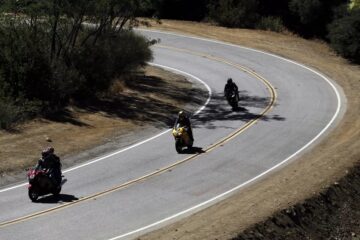The New Millennium Trail in Calabasas
Happy trails for all? When new homes are built next to wilderness areas, buyers and nature lovers battle over noise, parking and access. In Calabasas, they’ve figured out a way to keep the peace.
Source of this article – Los Angeles Times, November 7, 2004.
By DARRELL SATZMAN Special to The Times
BY the time it’s finished around the end of the year, an 8 mile trail snaking around the Oaks development of 550 mini-mansions in the Calabasas hills will oner the public a new place to take in the beauty of the Santa Monica Mountains.
The looping pathway will link up to an extensive network of mountain trails, permitting an intrepid hiker to start at the Oaks and trek all the way to the Pacific Ocean. Most believe it will be a boon to residents and the public alike, but realizing the trail has been no walk in the park.

OPENING SOON: The 8-mile hiking path at the Oaks development in Calabasas was a decade in the making.
Nearly a decade in the making, the path for hikers, mountain bikers and bird watchers represents a compromise among a private developer, the city of Calabasas and open-space advocates that some see as a model for future development in the county’s ecologically sensitive areas.
In parks-scarce Los Angeles County, new developments like the Oaks almost invariably trigger disagreements between property owners and those who look to wilderness areas as a respite from urban life.
The pervasive attitude of “not in my backyard,” it seems, extends even to hiking trails. Forget wildanimal encounters, it’s problems of a human nature that most trouble homeowners near the region’s natural hillsides and valleys.
Some environmentalists and recreation advocates maintain that homeowners want to enjoy the benefits of living next to open spaces without having to share those natural areas with outsiders. In some cases, they say, small pockets of residents are using their economic and political clout to control open space that taxpayers have spent millions of dollars to set aside for public use.
“I can understand why people don’t want a bunch of strangers walking by their house, but if the public buys the land, it should be open to everyone,” said Dave Brown, conservation chairman of the Sierra Club’s Santa Monica Mountains Task Force. “If you want to make it accessible to ordinary people, it can’t be something only a gung-ho backpacker can get to.”
Homeowners, on the other hand, argue that their attempts to regulate parking and trail access spring from legitimate concerns about privacy and safety. And there’s no dispute that nearby residents must deal with nuisances such as partyers and competition for parking.
“Some homeowners do feel very put upon,” said Michael Meyer, president of the Outpost Estates Homeowners Assn., which has been working to deal with such problems at the city-owned, 133 acre Runyon Canyon off-leash dog park in the Hollywood Hills.
“One of the issues is that ‘there are not enough of these parks,” Meyer said. “It isn’t fair to the neighbors for this one dog park to be the dog park for the entire region. It’s had a major impact on some of the adjacent streets.”
At times, overlapping or unclear jurisdictions cloud the issue for homeowners seeking redress. And often such debates are complicated by local politics, as is the case in Runyon Canyon. Meyer joined a city-appointed advisory board made up of area residents and trail users .that after five months forwarded a list of recommendations to the Department of Recreation and ;Parks.
In the end, the city came up with a plan that almost completely disregarded those recommendations. The advisory panel set up to appease residents, in the end, only added to their frustration, Meyer said. “It was a disappointing process.”
It’s an oft-repeated story in Southern California, and one that has become more pressing as the demand for new housing nudges development farther into hillsides and valleys that have remained relatively undisturbed.
The planned 21,000-unit Newhall Ranch is a prime example of how the various interests of government, landowners, environmentalists and recreation advocates are hashing out how the land will be shared in the future.
Legal obstacles
During the contentious battle that led to the approval of what will be a new city in L.A. County, just east of the Ventura County border, environmentalists managed to stall the process at several points with litigation involving endangered wildlife.
Ultimately, developer Newhall Land & Farming Co. agreed to set aside half of the project’s 12,000 acres as preserved open space and to build a trail system that will connect to other trails in the Santa Susana Mountains. The company also agreed to donate 64 acres of land, to remain undeveloped, that is home to the endangered San Femando Valley spineflower. Construction on the first homes could begin by 2006.
Meanwhile, disputes continue to crop up in areas developed decades ago. In the last year, the battle for public-beach access in Malibu has made headlines, as has an effort by Brentwood homeowners to control access to a trailhead near Mulholland Drive by means of an electronic gate.
The Crown Homeowners Assn. cited crime as its primary reason to build a guard-operated gate at Canyonback Road above the Sepulveda Pass. The Brentwood homeowners cited a rash of break-ins they said were limited to the few non-gated streets in the neighborhood. The Los Angeles City Council last year approved the plan before public outcry this summer led to a reversal. Now the gate sits half finished.
Albert Torres, chief park ranger for the city of Los Angeles, said crime is generally low and burglaries rarely an issue in the mostly affluent neighborhoods adjacent to the city’s natural areas, but he acknowledged residents’ fears.
“Usually it’s stuff that happens late at night when the parks are closed,” Torres said. “There’s quite a bit of partying in some areas, including up at Mulholland.”
Meyer, of the Outpost Estates group, said the partying factor also raises fire issues.
“We don’t want to be elitist and say, ‘This is our park and don’t anybody else use it,'” he said. “But a lot of these areas aren’t fenced well, and people are going into them at night and smoking and drinking.”
Others, however, say such arguments are not sufficient to deny access.
“It’s the Manson theory — that someone is going to hike in two miles and rob you,”, said Steve Harris, executive director of the Mountains Restoration Trust, which helps preserve and restore natural areas in the Santa Monica Mountains. “It doesn’t really occur, hut there’s a perception.”
In fact, some of those who argue for greater public access to the region’s natural areas say the presence of hikers, bikers and dog walkers make such areas safer. One of the most vocal of those groups is the Concerned Off-Road Bicyclists Assn., whose several hundred members use the region’s trails regularly.
“We’re riding the trail when [homeowners] are at work,” said Jeff Klinger, a CORBA board member. “And we’ve got eyes and ears and cellphones.”
So how is it that all of these competing viewpoints came to a consensus at the Oaks?
It took a lot of bargaining, cajoling and hand-wringing, according to those involved.

SWITCHBACKS: The Oaks trail winds around the gated community but doesn’t enter it, although it comes quite close to houses in some spots. Ultimately, homeowners were appeased, as were open-space advocates, the developer and the city.
“The trail use was an original condition, but it took a long time to get it done,” said Louis Malone, chief executive of Calabasas-based New Millennium Homes, developer of the Oaks, where prices begin at more than $1 million. About half the homes are completed or underway.
“There was disagreement at first, but once I saw the passion and fervor some people had, I got into it,” Malone said of the trail. “I think our community and the adjacent communities will view this as a benefit.”
All things being equal, close proximity to nature areas and open space can boost the price of a home 2% to 10% in Los Angeles County, real estate agents estimate.
“It’s a big bonus because, first of all, they have no neighbors on that side,” said Eric Lieberman, an agent with Prudential California Realty in Studio City. “Part of the attraction is seeing the deer grazing nearby and enjoying the privacy.”
Ed Dee, CORBA chairman and a real estate agent who until recently lived next to a trailhead near Serrania Park in Woodland Hills, said many recreation-minded home buyers are eager to find a house near open-space areas.
“I have clients who say it’s very important for them — for the view and for the access to the trails,” Dee said. “There are a ton of outdoor enthusiasts in the area.”
Plans for the large-scale development in the Calabasas hills that is now the Oaks actually began nearly two decades ago before the community was incorporated as a city.
When incorporation came in 1991, Calabasas inherited a development agreement that had been approved by Los Angeles County. It called for as many as 2,000 high-end homes spread throughout the 15,000-acre property.
That agreement was vigorously challenged, however, by city officials and environmental groups who argued the development was too big and too scattered. Ultimately, a deal was struck in the early ’90s for the current configuration, in which the homes would be clustered near the center of the property to preserve as much open space as possible.
New Millennium, which took over the project in 1997 after the original developer backed out, also agreed to donate 40% of the land — 600 acres — to the Santa Monica Mountains Conservancy, as well as to build a hiking trail that would be open to the public.
Vocal opposition
Although many Oaks residents were unaware of plans for the trail, some who got wind of the project began to voice objections.
“Issues did arise with people who don’t want the trail next to them,” said Joyce Parker, a planner who worked as a consultant for the city of Calabasas on the project. “Concerns ranged from security to privacy. People don’t want trail users looking into their backyards.”
New Millennium hired the nonprofit Mountains Restoration Trust to head the trail project and to work with the parties involved. The trust was charged with designing a trail that would be scenic, provide access to the larger Santa Monica Mountains trail system yet not intrude on the Oaks’ homeowners. The location for the trail was settled about two years ago.
The trail that’s being built winds around the gated community without ever entering it, though in some spots it does pass within a stone’s throw of houses.
Malone said he’ll spend about $500,000 on the trail — about $100,000 more than initially budgeted — and he’s had to make changes along the way to appease homeowners whose houses are near the path.
Still, he’s pleased with the way the project is turning out, and he said the compromises he made to get the development built have been worthwhile.
“From our standpoint, we’re glad to be preserving part of the land,” Malone said. “From a marketing perspective, it’s an asset once it gets completed.”
Klinger, of CORBA, also signed off on the deal.
“It’s a great example of the local community working with the developer and working with interest groups,” he said.
The Oaks is a lesson to other developers and residents that devising creative ways to share the land is often the path of least resistance, said the Sierra Club’s Brown.
“Local residents are eager to preserve their view,” he said, “but getting them to provide public access to it is sometimes difficult.”
Darrell Satzman is a Los Angeles-based freelance writer. He can be contacted at satsman@earthlink.net.


